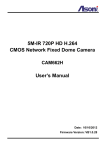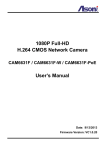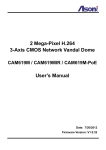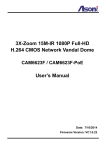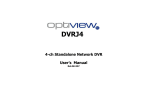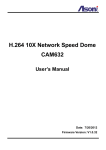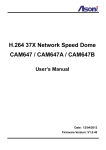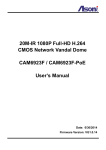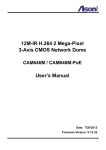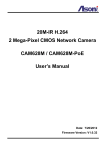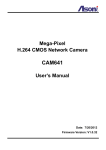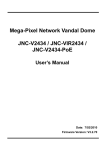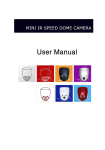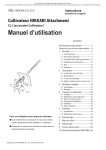Download CAM656 User`s Manual (English)
Transcript
H.264 36X Network Speed Dome CAM656D / CAM656D-PoE CAM656D-AP / CAM656D-BP CAM656D-PoE-AP / CAM656D-PoE-BP CAM656D-W-AP / CAM656D-W-BP User’s Manual Date: 7/20/2012 Firmware Version: V1.0.34 Content Content ....................................................................................................................................... 1 1. Preface ................................................................................................................................. 4 2. Product Specifications ....................................................................................................... 4 3. Product Installation ............................................................................................................ 7 A. Hardware Installation ...................................................................................................... 7 Indoor Embedded Mount ...................................................................................................... 7 Indoor Attached Mount (Fixed Ceiling) .................................................................................. 9 Outdoor Installation ............................................................................................................. 10 B. Cable Connections ........................................................................................................ 11 Part Names ......................................................................................................................... 11 Cables Connection.............................................................................................................. 12 I/O Connections .................................................................................................................. 13 C. Monitor Setting .............................................................................................................. 15 D. IP Assignment................................................................................................................ 16 4. Live Video .......................................................................................................................... 18 5. Configuration .................................................................................................................... 25 A. System ........................................................................................................................... 25 System Information ............................................................................................................. 25 User Management .............................................................................................................. 29 System Upgrade ................................................................................................................. 31 System Logs ....................................................................................................................... 32 B. Video/Audio Setting ...................................................................................................... 33 Video Format ...................................................................................................................... 33 Image Setting ...................................................................................................................... 36 Audio Setting ...................................................................................................................... 37 C. Network Setting ............................................................................................................. 38 Network Setting .................................................................................................................. 38 Wireless Setting .................................................................................................................. 42 Mail / FTP / Samba Setting ................................................................................................. 45 PPPoE Setting .................................................................................................................... 48 DDNS Setting ..................................................................................................................... 49 1 D. Event Handling .............................................................................................................. 51 Event Setting ...................................................................................................................... 51 I/O Setting ........................................................................................................................... 56 Schedule ............................................................................................................................. 58 6. OSD Menu.......................................................................................................................... 60 A. Language ....................................................................................................................... 60 B. System Information ....................................................................................................... 61 C. Reboot System .............................................................................................................. 61 D. Display Setup................................................................................................................. 61 Preset ID ............................................................................................................................. 62 Zoom Ratio ......................................................................................................................... 63 Alarm Message ................................................................................................................... 63 Date and Time .................................................................................................................... 63 Pan/Tilt Angle ...................................................................................................................... 64 Auto Pan ............................................................................................................................. 65 Area Title............................................................................................................................. 65 E. Dome Settings ............................................................................................................... 68 Camera – Regular Setting .................................................................................................. 68 Camera – Advanced Setting ............................................................................................... 69 Pan/Tilt ................................................................................................................................ 77 Presets................................................................................................................................ 80 Tours ................................................................................................................................... 82 Privacy Zones ..................................................................................................................... 84 Alarms................................................................................................................................. 85 Factory Initial ...................................................................................................................... 85 F. Schedule Setup ............................................................................................................. 86 Alarm In .............................................................................................................................. 86 Startup Auto Options ........................................................................................................... 86 Daylight Saving Time .......................................................................................................... 88 7. Network Configuration ..................................................................................................... 89 A. Intranet Only .................................................................................................................. 89 Connects to PC Directly ...................................................................................................... 89 Connects to an Exist LAN ................................................................................................... 90 B. Internet Only .................................................................................................................. 91 2 Connects to ADSL with Fixed Public IP Address ................................................................. 91 Connects to ADSL with Floating Public IP Address (PPPoE) .............................................. 92 C. Intranet + Internet .......................................................................................................... 94 Connects to Internet with Fixed Public IP Address.............................................................. 94 Connects to Internet with Floating Public IP Address.......................................................... 96 8. Factory Default .................................................................................................................. 97 3 1. Preface This camera is a network speed dome camera. It builds in web server. User views real-time video via IE browser. It supports H.264, JPEG and MPEG4 (3GPP Only) video compression which provides smooth and high quality video. This camera is equipped with high resolution CCD sensor and powerful 36X zoom lens that can used for wide angle observation and detail viewing to the far-end object as well. The PT mechanism provides controllable pan and tilt functions, giving users the capability to manipulate the camera for precise locating on targets for monitoring. The built-in micro-controller allows users to program up to 128 presets for quick and accurate capture to specific view positions. Majority of image related functions (such as DSP functions, lens functions, special effects of video…) are managed via OSD (On-Screen-Display) menu. These functions are explained in the section of OSD with details. The CCD can be set up for automatic switching to black-white mode for improving image quality in weak-light or dark condition. 2. Product Specifications H.264 / MJPEG / MPEG4 (3GPP Only) compression formats. Supports resolution up to 30/25 fps @ Full D1 (720x480 / 720x576) H.264 / MJPEG / MPEG4 (3GPP Only) triple streaming. Self-Contained HTTP Web Server providing Internet capability for remote access 36X optical zoom and 256X digital zoom Up to 128 programmed preset points 650 Horizontal TV lines WDR (Wide-Dynamic-Range) function used for one scene that has part in high light and other part is much darker. Built-in ICR (IR Cut Filter) provides Day & Night functionality for 24-hours surveillance Built-in PoE splitter, support for Power over Ethernet (PoE model) Wireless network connection (Wireless model) 2-way audio Online firmware upgrade 4 Model Indoor Model Outdoor Model Hardware CPU / RAM / ROM ARM 9, 32 bit RISC / 256MB / 16MB Image Sensor 1/4" Sony 960H CCD, Color: 650 TV lines, Mono: 700 TV lines Lens 1/4", 36X Zoom Lens 3.3 ~ 119 mm, F1.6 ~ 360 Day / Night Mechanical IR Cut Filter Illumination Color mode: 0.1 lux, WDR WDR (wide-dynamic-range) for strong daylight Video Out 1 Analog video out (BNC connector) Audio In / Out 1 Line in / 1 Line out (3.5mm phone jacks) Digital I/O 2 Digital in / 2 Digital out RS-485 Connector Yes, for connecting an external RS-485 keyboard Water Proof - IP-66 standard Power Supply Non-PoE model: DC 12V, 3A Non-PoE model: DC 12V, 3A PoE model: Embedded PoE Splitter PoE model: Embedded PoE Splitter (IEEE 802.3at) (IEEE 802.3at) Power Consumption Max. 19 Watt Max. 26 Watt Dimensions Φ145 x H238 mm Φ240 x H326 mm (without bracket) Mono mode: 0.05 lux Network Ethernet 10/ 100 Base-T Wireless (Wireless model) 802.11b/g/n, supports WPA-PSK, WPA2-PSK, WEP 64/ 128 bit Network Protocol HTTP, TCP/IP, RTP/RTSP, 3GPP, NTP, SMTP, FTP, PPPoE, DHCP, DDNS, UPnP System Video Resolution NTSC: 720x480, 704x480, 352x240, 176x120 PAL: 720x576, 704x576, 352x288, 176x144 Compression Format H.264 / MJPEG / MPEG-4 (3GPP only) Frame Rate Up to 30 FPS Triple Streaming Yes (2 for live view, 1 for 3GPP) 3GPP Yes, Live view with 3G mobile phone Video Bitrate Adjustment CBR, VBR Pan / Tilt / Zoom Control Yes, remotely Zoom Ratio Optical 36X, Digital 256X Pan Angle 360 , continuous Tilt Angle -6 ~ +96 Pan/ Tilt Speed Manual: Approx. 0.15 /sec ~ 120 /sec o o o o o o o Call Preset: Approx. 1 /sec ~ 255 /sec Preset Point 128 Preset points 5 Auto Patrol Mode Pan-Scan / Preset-Sequential / Preset-Tour / Patrol-Record-Path Focus/ Iris Auto / Manually Privacy Zone 8 Privacy zones (On / Off / Edit in OSD Menu) Motion Detection Yes, 3 different areas Event Trigger Motion Detection, Digital In Triggered Action Send Email, Send to FTP, Digital Out Pre/ Post Alarm Yes, configurable Security Password protection Firmware Upgrade HTTP mode, can be upgraded remotely Connection Up to 10 clients simultaneously Audio Yes, 2-way Web browsing requirement OS Windows 2000, XP, Vista, Windows 7 Web Browser Microsoft IE V7.0 (32-bit) or above, Mozilla Firefox V6.0 or above, Opera V11.5 or above, Safari V5.1 or above, Google Chrome V13.0 or above Suggested Hardware Intel Core 2 Duo 1.66GHz, RAM: 1GB Graphic card: 128MB onboard RAM * Specifications are subject to change without notice 6 3. Product Installation A. Hardware Installation Indoor Embedded Mount Turn anti-clockwise to remove the Ceiling-ring from Decoration-ring. Release these 3 screws Release 3 screws, turn anti-clockwise to separate the Ceiling-ring and Fix-ring. Attach the Ceiling-ring to ceiling. Put 3 screws through the Ceiling-ring and ceiling, and then fix in the hole of Fix-irons. 7 Release these 3 screws Fix the Fix-ring and Hold-ring with 3 Turn anti-clockwise to take off the Dome-cover. Release 3 screws screws. and take off the Upper-body. Tighten these 3 screws Put the Upper-body and 3 screws into Put the Upper-body, Fix-ring and Hold-ring into body, tighten 3 the set of Fix-ring and Hold-ring. screws to fix them with body. Put the camera into the hole of ceiling, turn camera Put on Decoration-ring, turn it clockwise clockwise to tight position. Tighten 3 screws to fix to tight position. Attach the Dome-cover Ceiling-ring and Fix-ring. and turn it clockwise to tight position. The installation is finish. 8 Indoor Attached Mount (Fixed Ceiling) Release these 2 screws Release 2 screws from base, turn the body Put the Rubber-cover to cover the hole besides the clockwise to separate the body and base. cables. Attach base to ceiling, tighten 3 screws into ceiling. Tighten these 2 screws Attach body to base (align to the connector), Fix camera body and base with 2 screws. The turn body anti-clockwise to tight position. installation is finish. 9 Outdoor Installation Release these 4 screws The PoE model doesn’t need adapter. Release 4 screws to separate the bracket and power box. Fix the adapter and connect the AC cord. Tighten these 3 screws Connect the safety-wire between camera and Attach the camera and bracket (align the gap), and then bracket, and then put all cables into the bracket. tighten the 3 screws on the neck of bracket. AC Cord: AC 90V ~ 260V Brown: AC Line Blue: AC Line Yellow/Green: Ground Insert the outer cables (AC cord, Ethernet cable, and the others) through here. Put the cables inside the power box, connect the power cord and adapter. Insert the outer cables (AC cord, Ethernet cable, and the others) through the water-proof tubes, and connect them in the power box. Tighten the 4 screws to fix the bracket and power box. The installation is finish. 10 B. Cable Connections Part Names Indoor Model Power Jack (DC 12V) (Red) Audio Input (Green) Audio Output RS485 Connector Analog Video Output Digital I/O Network Connector Outdoor Model Power Jack (DC 12V) (Red) Audio Input (Green) Audio Output RS485 Connector Analog Video Output Digital I/O Network Connector 11 Power Jack: To connect the included power adapter. Audio Input (Red): The 3.5mm jack allows connect to a microphone or audio source, the connected audio will be heard at the remote site. Audio Output (Green): The 3.5mm jack allows connect to an amplified speaker, you can hear the voice of the remote site from the speaker. RS485 Connector: The terminal block allows connect to an external keyboard. Analog Video Output: The BNC connector allows connect to the analog display to output analog video for locally monitoring. I/O Connector: This connector allows connect to the extend cable (included) and provides the following outputs: Brown: Digital Input 1 Gray: Digital Input 2 White: GND Black: GND Red: +5V Green: Digital Output 1 Orange: Digital Output 2 Blue: GND Yellow: Hardware Reset Violet: GND Network Connector: The RJ-45 connector allows connect the Ethernet cable. Cables Connection 1. Connect the cable of Digital I/O, Video output, Audio output and Audio input if you want to use these functionalities. 2. Connect Ethernet cable for network connection. 3. Connect power adapter to turn on the camera. 4. If the camera is PoE model, the power adapter is not necessary. The camera will get the power from the PoE injector or PoE switch. 12 PoE (Power over Ethernet) is a technology that integrates power into a standard LAN infrastructure. It enables power to be provided to the network device, such as an IP phone or a network camera, using the same cable as that used for network connection. It eliminates the need for power outlets at the camera locations. Please follow the below figure for the connection. PoE Switch or PoE Injector PoE Network Camera To Network Ethernet Cable Data only Ethernet Cable Mixed data and power 5. Set up the network configurations according to the network environment. For further explanation, please refer to Network Configuration chapter. I/O Connections Connect the I/O connector with the extend I/O cable (included in the package). Note: Use tape to cover the unused wires to avoid unexpected contact to others. Brown: Digital Input 1 Green: Digital Output 1 Gray: Digital Input 2 Orange: Digital Output 2 White: GND Blue: GND Black: GND Yellow: Hardware Reset Red: +5V Violet: GND 13 2 sets of Digital Input (Digital In + GND) – The digital inputs for connecting devices that can toggle between an open and closed circuit, such as PIRs, door/window contacts, etc. When a signal is received the status changes and the input becomes active. 2 sets of Digital Output (Digital Out + GND) – The output to Relay Box or Relay Board, and switch on the alarm device such as LEDs, Sirens, etc. Brown Digital IN 1 Gray Black Green Digital IN 2 Digital OUT 1 Orange Digital OUT 2 Violet Digital Input (Alarm Input) GND (Ground): Initial status is LOW. Digital In: Max. 50mA, 12VDC. Brown Black Door/Window Contacts Digital Output (Alarm Output) Green Violet 14 Relay Board or Relay Box C. Monitor Setting 1. Right-Click on the desktop. Select “Properties” 2. Change color quality to “Highest (32bit)”. 15 D. IP Assignment Always consult your network administrator before assigning an IP address to your camera in order to avoid using a previously assigned IP address. MAC Address: Each network camera has a unique Ethernet address (MAC address) shown on the sticker of the device. One final note, although the IP Search is able to find and configure any network device on the LAN except those that are behind a router, it is a good idea to set the host PC to the same subnet. In order to connect to the Web-based user interface of the network camera, the host PC must be in the same subnet. For more information about subnets, please consult your network administrator. “Asoni IP Search” is a utility that provides an easier, more efficient way to configure the IP address and network settings of the network camera in Local Network (LAN). The software can be installed from the attached software CD. 1. Once “Asoni IP Search” has been successfully installed on the computer, double click the “Search CAM4_CAM6_NVR6LX” icon on the desktop. 16 2. IP Search searches all the network devices which connect to the intranet and lists on the window. Click [Search] button to search again. 3. From the list, click and select the device with the MAC Address that corresponds to the device that is to be configured. 4. The network configuration of the selected device will show on the bottom, filling in the Device Name, IP Address, Subnet Mask, Gateway and the others. 5. Click [Modify] button to save the settings into the device. 6. Wait for few seconds to let the device update the settings, and then click [Search] button again to re-search the network devices. 7. Double-click the network device listed on the window, It will open an IE browser and connect to this device directly. 17 4. Live Video Start the IE browser, type the IP address of the network camera in the address field: http://<IP of camera> If the “HTTP Port” has been changed from “80”, type the URL as: http://<IP of camera>:<HTTP Port> After link to the camera, it will show a dialogue box. Key-in the user name and password to log-in and open the web page of camera. The default user name and password are “admin” and “admin”. For the first time to view the camera video via IE, it will ask you to install the ActiveX component. If the installation failed, please check the security setting for the IE browser. 1. In IE, click on [Tools] [Internet Options…] 2. Click on [Security] Tab [Custom Level…] 3. In Security Settings, under [Download unsigned ActiveX controls], select “Enable” or “Prompt”. 4. In Security Settings, under [Initialize and script ActiveX controls not marked as safe], select “Enable” or “Prompt”. 5. When pop-up window with warning message, click [Yes] to save the settings. 18 1 2 3 4 5 When popup the following dialogue box, click [Yes]. 19 The web page of the device shows as following. If you are using IE 8.0 or above, please click “Compatibility View” icon to make this web page works properly: ⑤ ① ② ③ ⑥ ⑧ ⑨ ⑦ ④ ⑩ Streaming : Select the streaming 1 or 2 from the pull-down list to display. Language : Change the display language temporarily. Note: The display language is changed temporarily for current connection, and it doesn’t change the default language. To change the default language, please go to Configuration System Information page. Configuration : Go into the configuration page to set the parameters if necessary. Status Bar : Shows system date/time, video resolution and video refresh rate (FPS). 20 Online Visitor : Shows how many users connect to this device. OSD Menu : This camera has many functions available to users for setting and adjusting. Most advanced functions are accessible through OSD (On-Screen-Display) Menu. Please refer to OSD Menu chapter for the operation. P/T Control Panel, Zoom, Focus and Iris : Pan / Tilt the camera: Pan/Tilt Control Press direction button to pan or tilt camera. Click Move camera back to the home position: button. The home position must be specified in OSD Menu Dome Settings Pan/Tilt Home Position first. Speed Adjust the speed of the camera movement: Select the speed from the pull-down list, higher value is faster. Zoom (Step) Adjust the zoom ratio step by step: Click or button to zoom-in or zoom-out the camera. Pressing or button to zoom-in or zoom-out, the camera will keep zooming until you release the button. Zoom (Cont) Adjust the zoom ratio continuously: Note: Since the video transfer will be delayed with slow network, it is difficult to stop the zooming at the correct position, please do not use this operation via Internet. Click Focus to adjust focus automatically. Adjust the focus: Click or Click Iris to manually adjust focus. to adjust iris automatically. Adjust the Iris: Click 21 or to manually adjust iris. Auto Pan : Click button to open the Auto Pan control panel as below. Scan (Pan scan): This is for continuous panning between two positions A / B. To start this mode, please enter OSD Menu Dome Settings Pan/Tilt Auto Mode and complete the settings of start position, end position, moving speed and dwell first. Choose the Auto Pan mode from the pull-down list: Seq (Point 1~16): This mode makes camera move around all the preset 1 to 16 sequentially. Tour 1/2 (Selected points): To make camera move around all the selected presets. You can select the presets in OSD Menu Dome Settings Tours. Patrol (Recorded path): To make camera patrol the previous recorded path. You can record the path in OSD Menu Dome Settings Pan/Tilt Auto Mode. Auto Pan Select the Auto Pan mode from the pull-down list, and Setup Auto Pan: then click [Setup] button to direct enter the OSD to setup this mode. Start “Patrol”: Click button. Stop “Patrol”: Click button. 22 Preset Point : Click button to open the Preset Point panel as below. Select the preset from pull-down list, move camera to the desired position, input a name in Set / Change Preset Point: “Name” box, and then click Preset Point button. Select the preset from pull-down list and then Go to Preset Point: click [Go], camera will go to the position. Select the preset from pull-down list and then Remove Preset Point: click button. Function Buttons : Click these buttons will perform the following functions. Full Screen : Click this button or double-click the video, the video will change to full screen mode. Press [Esc] key or double-click the video again, it will back to normal mode. Snapshot : Click this button to take snapshot of the video. The image will be displayed in a pop-up window, click to save as a jpg picture. Record : Click this button to record the video into the local PC. It will ask you where to save the video. To stop recording, click this button again. The saved video format is AVI. The recorded file can be played by Microsoft Media Player. Note, H.264 decoder must be installed to play the recorded file. You can install “FFdshow” from the included CD for the decoder. 23 Chatting : The camera supports 2-way audio. Click this button, then you can use microphone which connected to the PC to talk to the camera side. Voice : Click this button to turn on the audio from camera. Click again to turn off it. Digital Zoom : Click this button, a pop-up window appears. You can enable / disable the digital zoom, and adjust the ratio. Relay Out (ON/OFF Switch) : Click the button to manually turn on / off the built-in Digital Out. Relay Out (Time Switch) : Click the button to manually turn on the built-in Digital Out, after the interval time is passed, the Digital Out will be turned off automatically. The interval time can be set up in Configuration Event Handling I/O. 24 5. Configuration Click [Configuration] button to get into the configuration page. Click button to back to the Live-View page. A. System System Information Set up the camera name, select language, and set up the camera time. System Information 25 [Live View] Server Information MAC Address: The MAC address of the Ethernet network card in the device. Server Name: You can type a name into this field to identify this device. Show on Status Bar: Determine whether show the server name on the Status Bar. Default Language: Select the default language for the user interface. OSD Setting Time Stamp: Enable this option will display the date and time on the video. Position: Select the display position of Time stamp. Text: Enable this option will display the OSD string on the video. Text Edit: Click this button to open “Text Edit” dialog window. You can change the OSD string and adjust the size and alpha of the text. After editing, click [Upgrade] button. 26 Time Setting Date Format: Select the format to display the date. Time Zone: Select the GMT to match your time zone. Enable Daylight Saving: If using “Daylight Saving”, enable this option and select the start and end time. Synchronize with NTP Server: Select this option and type the IP address of a NTP (Network Time Protocol) server, this device will synchronize the time with the NTP server via network. NTP Server: Type the IP address or URL of the NTP server. Update Schedule: Select the interval for the update time. For example, if select “6 Hours”, this device will synchronize the date and time with the NTP server every 6 hours. Synchronize with PC’s time: Select this option will synchronize the device time with the PC’s time. Manually Input Date and Time: Manually input the date and time. 27 The date and time remain the same: Keep the current date and time without change. After set up, click [Apply] to save the settings. 28 User Management You can add, remove and manage the users in this page. This device supports 4 user groups: Administrator: The administrator can view, operate and configure all functions and settings of this device. PTZ: The users in PTZ group can view and operate all functions in Live-View page. Guest: The users in Guest group can only view the live video in Live-View page. Anonymous: The anonymous user can only view the live video in Live-View page. The privilege is same as Guest group. User Management Anonymous User Login To allow user visit this device without login, select [Yes] and then click [Setting] to enable this function. Add User To add a new user, type the user name and password, select the User Group, and 29 then click [Add/Set] to save the user. User List This table lists the current users. Edit: To change the username and password, click [Edit] and modify the administrator or user in the pop-up window. Remove: To remove the user, click [Remove]. 30 System Upgrade This page allows user to upgrade firmware, restart device and restore the factory default settings. System Upgrade Firmware Upgrade The firmware can be upgraded online. To update the firmware, click [Browse…] to select the new firmware file, and then click [Upgrade] to the procedure. Reboot System To restart the device, click [Reboot] and then click [Yes] on the prompted window. Factory Default To load the factory defaults, click [Default] and then click [Yes] on the prompted window. Note, all settings including User account, Network, A/V and Event settings will be restored to the factory defaults. 31 System Logs System Logs System Status Logs Click the [View] button on the right side to list the logs of system status. Motion Trigger Logs Click the [View] button on the right side to list the logs of motion detection. Digital-In Trigger Logs Click the [View] button on the right side to list the logs of digital input detection. All Logs Click the [View] button on the right side to list all logs. 32 B. Video/Audio Setting Video Format This device supports H.264/MJPEG and MPEG4 (only for 3GPP streaming) Triple Mode and Triple Streaming, set the video parameters in this page. Video Format 33 Streaming 1 and 2 Output Setting Basic / Advanced Mode: Select the mode to configure the parameters. Advanced mode provides more detail parameters for setting. Resolution: Select the resolution from the pull-down list. Frame Rate Per Second: The video refreshing rate per second. Select the frame rate from the pull-down list. Video Compression Format: Choose H.264 or JPEG format to compress and output the video stream. H.264: The video stream will be compressed in H.264 format. Choose CBR (Constant Bit Rate) or VBR (Variable Bit Rate) in Bitrate Control Mode. CBR: Set the Video Bitrate from 32Kbps ~ 4Mbps depend on the upload bandwidth of network. The data size of video stream will be limited under the selected bit rate. VBR: Set the Video Quantitative from 1 ~ 10, the higher value will get better video quality. The data size of video stream is no limitation, if the upload bandwidth of network is lower than the data size, the video will be displayed slowly. GOP Size: Set the GOP (Group of Picture) size. If you don’t know what value should be set, please set it to “1XFPS”. JPEG: The video stream will be compressed in MJPEG format. Quality: 5 levels for select. The higher quality will get bigger file size. RTSP Path: Assign a name to identify this video stream. When view the video stream with RTSP connection, the URL should be “rtsp://<Public IP of this device>:<RTSP port>/<RTSP path>”. 3GPP Streaming Output Setting After enable the 3GPP streaming, it will enable this device to send out the video in 3GPP format, and you can view the live video on the 3G mobile phone. 34 Since the bandwidth of 3G is not fast usually, the 3GPP streaming will be set to the following configuration: Resolution – Fixed to 176x144. Frame Rate –Fixed to 5FPS. Video Format – Fixed to MPEG4. Audio Format – Fixed to AMR. 3GPP Path: Assign a name to identify the 3GPP video stream To view the live video with a 3G mobile phone or PDA, open “Streaming Player” or web browser in the mobile phone, type the URL as following to link and view the live video: rtsp://<Public IP of camera>:<RTSP port>/<3GPP path> * <Public IP of camera>: The public IP address of the camera. * <RTSP port>: The RTSP port of the camera. This port is assigned in Configuration Network Setting Network Setting * <3GPP path>: The name of the 3GPP video stream. If your 3G mobile phone or PDA does not support the viewing of RTSP streaming, you can view the camera with http connection. To do this, use a Java compliant browser such as Opera, and type the URL as following to link and view the live video: http://<Public IP of camera>:<HTTP port>/Jview.html * <Public IP of camera>: The public IP address of the camera. * <HTTP port>: The HTTP port of the camera. This port is assigned in Configuration Network Setting Network Setting Note: Do not use the IE browser in 3G mobile phone because it doesn’t support Java. After set up, click [Apply] to save the settings. 35 Image Setting Image Setting Privacy Mask For the security purpose, there are 3 areas can be setup for privacy masks, the masked areas will not be shown in Live-View and recorded file. To set up or clear the privacy mask, click [Draw/Clear Area] button, and then use mouse to drag the area on the video. After the configuration, click [Save Area Settings] button to save the settings. Image Quality Brightness / Contrast / Hue / Saturation / Sharpness: You can adjust these parameters to get clear video. Default: Click [Default] button will load the default settings. 36 Audio Setting This device supports 2-way audio. Audio from Device to Local PC For this device to local PC, select [Enable] and then click [Apply] to start this function. If set to [Disable], the [Voice] icon on Live View page is not workable. Audio Setting Audio from Local PC to This Device For local PC to this device, click [Chatting] icon on the Live View page. 37 C. Network Setting Network Setting Network Setting 38 IP Assignment DHCP: If this device behinds a router and the router provides DHCP service, using DHCP, this device will get all network parameters from the router automatically. Static: Assign IP address, subnet mask, gateway, and DNS manually. Port Assignment Set the port if necessary. If this device will be connected via Internet, configure the NAT (Network Address Translation) in router to match the port assignment. HTTP Port: Set the port for HTTP connection. The default is “80”, change the port if you want to use router’s NAT (Network Address Translation) to make this device can be linked from Internet. UPnP Setting UPnP: Enable or disable the UPnP protocol. This device supports UPnP, if the UPnP service is enabled on your computer, the device will automatically be detected and a new icon will be added to “My Network Places”. Note: UPnP service must be enabled on your computer. The Windows Vista and Windows 7 have enabled UPnP service by default. To activate UPnP service in Windows XP, please follow the procedure: 1. Open the “Control Panel” from the “Start” menu. 2. Select “Add/Remove Programs”. 3. Select “Add/Remove Windows Components” and open “Networking Services” section. 4. Click “Details” and select “UPnP” to setup the service. 5. The network device icon will be added to “My Network Places”. 6. You may double-click the network device icon to access it via IE browser. UPnP Port Forwarding: Enable or disable the “UPnP Port Forwarding” function. The “UPnP Port Forwarding” function provides an easy way to configure the NAT (Network Address Translation) in router. If the router equips “UPnP Port Forwarding” function too, this device will ask the router to open the “External HTTP Port” and “External RTSP Port” for this device automatically. Therefore, you don’t need to configure the Port Forwarding manually. Note: Not all routers equip “UPnP Port Forwarding” function. The device will report whether this function is successful after click [Apply] button. 39 RTSP Server Setting RTSP Server: The video stream can be direct retrieve via RTSP connection, you can close this function by disable this option. RTSP Authentication: If you select and enable this function, the remote client must meet the authentication to retrieve video stream via RTSP connection. RTSP Port: Set the port for transfer the video and audio. The default is “554”, change the port if you want to use router’s NAT (Network Address Translation) to make this device can be linked from Internet. RTP Port: Set the port range of RTP port. In RTSP mode, you may use TCP and UDP for connecting. TCP connection uses RTSP Port. UDP connection uses RTP Start and End Port. Multicast Setting (Based on the RTSP Server) Multicast addressing is a network technology for the delivery of streaming to a group of destinations simultaneously using the most efficient strategy to deliver the messages over each link of the network only once, creating copies only when the links to the multiple destinations split. To implement the Multicast, a switch or router that supports Multicast function is necessary in the network. If your network supports Multicast, you can configure the device to enable this function by setup the following: IP Address: This is the multicast group address the streaming should be sent to. You should configure each recipient with the same multicast group address and receive the streaming from this address. The range is 224.3.1.0 ~ 239.255.255.255 Port: The multicast port. The range is 1 ~ 65535 TTL: Time-To-Live (TTL) for Multicast Packets. This value decides how "far" from a sending host a given multicast packet should be forwarded. Onvif Setting This device supports Onvif standard, you can configure the following settings to compatible with the NVC (Network Video Client) such as NVR or recording software: Onvif Version: Select the version of Onvif standard, or disable the Onvif output. 40 Security: Enable or disable the Onvif security authentication. RTSP Keepalive: If select “Enable”, when the NVC doesn’t send the command for keeping the RTSP connection, this device will terminate the RTSP connection. If select “Disable”, this device will always keep the RTSP connection. If the “Time-out” error happens on NVC side, please disable this function. After set up, click [Apply] to save the settings. 41 Wireless Setting The Wireless model supports Wireless network connection, set the parameters in this page. Note: Wireless network and Ethernet network use the same IP, user has to unplug Ethernet cable to activate the Wireless connection. If Ethernet cable is plugged, Wireless connection will be stopped. Wireless Found Wireless Networks The Wireless model will automatic search the available Wireless network and list in the SSID table. Please refer to the table to set the Wireless settings. Wireless Setting Mode: Select the mode of the connection from the pull-down list. “Infrastructure” is for connecting with the router. “Ad-hoc” is for connecting with PC directly. Operation Mode: Select the mode from the pull-down list. SSID: Choose a Wireless network from the SSID table, and type the SSID in the box. The SSID is case-sensitive. Security: Select the security mode to match the Wireless network. It supports “None”, “WEP”, “WPA-PSK”, “WPA2-PSK” security encryption based on the setting of Router. Ad-hoc Ad-hoc is for connecting with PC directly. There is “Channel” to selected only when uses Ad-hoc mode. For example, if PC’s channel is 6, the “Channel” has to be 6 too. 42 WEP Setting The Wireless model supports “WEP” security encryption. The settings must be same as the Router’s setting. Consult your network administrator to set the parameters. 43 Authentication: There are “Open System” and “Shared Keys”, it is based on different encryptions. This has to be the same as the Router’s setting. Encryption: There are 64 bits and 128 bits. This is based on Key Type based on the Router’s setting. Key Type: There are HEX and ASCII. When selecting HEX, the user only can input 0~9 characters and use A, B, C, D, E, and F. When selecting ASCII, the user can input any character (case [upper cases/ lower cases] sensitive). Key 1~4: Based on Key Type to input characters. WPA-PSK Setting The Wireless model supports “WPA-PSK” and “WPA2-PSK” security encryption. The settings must be same as the Router’s setting. Consult your network administrator to set the parameters. Encryption: There are “TKIP” and “AES”. Pre-Shared Key: Allow any characters (case [upper cases/ lower cases] sensitive). After set up, click [Apply] to save the settings. 44 Mail / FTP / Samba Setting To send out the event video to E-mail, FTP or Samba network storage, please set up the configuration first. Mail / FTP/ Samba 45 Mail Setting Login Method: This device provides 2 kinds of mail settings. “Anonymous” for the mail server which doesn’t need login with user name and password. “Account” for the mail server which needs login with user name and password. Send Mail Server: The IP address or URL of the send-mail server. User Name / Password: The user name and password of the sender to login mail server and send the mail. Sender’s Mail: The sender’s mail address. Receiver’s Mail: The receiver’s mail address. BCC Mail: The mail address to receive the mail also. Mail Port: The port of the mail service. Default is 25. FTP Setting FTP Server: The IP address or URL of the FTP server. User Name / Password: The user name and password to log in the FTP server. 46 FTP Port: The port of the FTP service. Default is 21. Store Path: The path to save the sent video file. FTP Mode: Select “PORT” or “PASV to fit the FTP server. “PORT” is for sending file to an Active FTP server; “PASV” is for sending file to a Passive FTP server. Auto Create Folder by Date: If select “Yes”, a folder will be created under the “Store Path” and named with the date, and then the video file will be saved in this folder. If select “No”, the video file will be saved in the “Store Path” without folder. Samba (Network Storage) Setting “Samba” is a networking protocol provides file sharing service between network devices. If you have a network storage is running Samba service, this camera can send the event video or snapshot to the network storage directly. NAS Location: The location of the Samba network storage, including IP address or URL and the folder, the event video or snapshot will be send to this location. Workgroup: Type the work group this Samba network storage belong to. User Name / Password: The user name and password to log in the Samba network storage. Auto Create Folder by Date: If select “Yes”, a folder will be created under the “NAS Location” and named with the date, and then the video file will be saved in this folder. If select “No”, the video file will be saved in the “NAS Location” without folder. After set up, click [Apply] to save the settings. Test the Settings You can click [Test] button, this device will send a test mail to receiver’s mail box, or upload a test file to FTP site and the Samba network storage, to make sure the settings of mail, FTP or Samba network storage are correct. 47 PPPoE Setting If this device connects to an ADSL modem directly and want to use PPPoE connection, set the parameters in this page. PPPoE Setting PPPoE Connection Select [Enable] to use PPPoE. Type in user name and password for the ADSL connection. Send E-mail After Dialed If select [Enable], when connect to the Internet via PPPoE, this device will send a mail with the Subject to a specific mail account, this mail contains the public IP address of the ADSL connection. To set the mail account, please refer to Configuration Network Setting Mail&FTP page. E-mail Subject The subject of the E-mail will be sent. After set up, click [Apply] to save the settings. 48 DDNS Setting This device supports DDNS, set the parameters in this page. DDNS Setting DDNS Setting There are several DDNS providers can be selected. Select the provider from the pull-down list, input Hostname, User name, Password and the Schedule Update time, and then click [Apply] to connect to the DDNS provider. Status This field will display the message to indicate the status of DDNS service. Updating: Information update. Idle: Stop service. http://<hostname (username)>.<provider>.com: DDNS registration successful, can now link to the device with this URL address. Update Failed, the name is already registered: The hostname or username has already been used. Please change it. 49 Update Failed, check your internet connection: Network connection failed. Update Failed, please check the account information with you provider: The input hostname, username or password may be wrong. 50 D. Event Handling Event Setting This device supports multiple event settings. Event This device supports 2 kinds of event detections: Motion Detection. Digital Input Detection. 51 Motion Detection This device allows 3 areas for detect motion. When motion detection is triggered, it can send the video or snapshot to specific mail address; transmit the video or snapshot to remote FTP server or Samba network storage; trigger the digital out. Set the Area: To set up or clear the motion area, click [Draw/Clear Area] button on “Set Area” row, and then use mouse to drag the area on the video. Adjust the Sensitivity: To adjust the sensitivity of detection, select the level from the pull-down list. Activate Motion Detection: To activate the motion detection, enable the [Detect Area] check box Actions when Motion Detection is Trigger: Select what actions will be taken once the motion detection is triggered in each area. E-mail: When the motion detection is triggered in this area, send the recorded video or snapshot to the specific mail address. 52 FTP: When the motion detection is triggered in this area, send the recorded video or snapshot to the specific FTP site. Save to Samba: When the motion detection is triggered in this area, send the recorded video or snapshot to the Samba network storage. To set the mail account FTP site and Samba network storage, please refer to Configuration Network Setting Mail&FTP page. Out1 / Out2: When the motion detection is triggered in this area, turn on the Digital Output 1 or Digital Output 2. E-Mail Subject: The subject of the E-mail will be sent. Detection Interval: This option provides two functions: The interval time between multiple detections. For example, if the time set to 10 seconds, when the motion detection is triggered at time 10H:05M:10S, the next detection will be accepted after 10H:05M:20S. The detections between 10H:05M:10S to 10H:05M:19S will not be accepted. If the “Out” is selected for the action, the Interval means “Digital Output On” period. For example, if Interval set to 20 seconds, when the motion detection is triggered, the Digital Output will be “On” and lasting for 20 seconds, and then “Off” automatically. Enable Motion Detection in Schedule Time: Enable this option will automatic activate the motion detection with scheduled time and stop the detection in the other time. Please refer to Schedule page to setup the schedule time. Recommendation of Motion Detection Area To ensure the Motion Detection works well, and avoid unnecessary trigger, please follow the rules to draw the Motion Detection Areas: The moving object larger than the 50% of the Motion Detection Area, it will be detected, and the Motion Detection is triggered. The moving object smaller than the 50% of the Motion Detection Area, it will not be detected, and the Motion Detection will not be triggered. Recommend use 3 smaller Motion Detection Areas to replace a large area. 53 Motion! The moving object smaller than the 50% of the The moving object larger than the 50% of the motion motion area, it will not be detected! area, it will be detected, and the motion is triggered! To detect the smaller moving object, use 3 motion areas to replace a large motion area, refer the figure below: Motion! The moving object will be detected when it is in any of the 3 motion areas, and the motion is triggered! Record File Setting There are 3 methods to record the event video and send out via E-mail, FTP: Video: When an event (Motion Detection or Digital Input Detection) is triggered, the video will be recorded as still image with AVI format. The beginning and ending time of the file is depending on the Pre and Post Record Time Setting. Snapshots: This option is available when the “Video Format” of streaming 1 is set as “JPEG” in Video Format. When an event (Motion Detection or Digital Input Detection) is triggered, this device will take a series of snapshot with JPG format. The beginning and ending time of the snapshot pictures is depending on the Pre and Post Record Time Setting. 54 Snapshot (Single): This option is available when the “Video Format” of streaming 1 is set as “JPEG” in Video Format page. When an event (Motion Detection or Digital Input Detection) is triggered, this device will take a snapshot with JPG format. Pre and Post Record Time Setting Configure the record time for the event recording file. For example, if set “Pre Alarm” as 3 seconds and set “Post Alarm” as 5 seconds, when an event (Motion Detection or Digital Input Detection) is triggered at time 10H:05M:10S, the video will be recorded from 10H:05M:07S to 10H:05M:14S. Note: Limited by the built-in RAM of this device, when data is too much or video quality set too high, it will cause recording frame drop or decrease the recording time of post alarm. To avoid the “frame drop” situation, please reduce the bitrate of the video. We recommend connect the device in LAN (Local Network) and set the video as CBR, and Bitrate less than 1.5Mbps. After set up, click [Apply] to save the settings. 55 I/O Setting This device provides Digital Input and Digital Output. When the Digital Input is triggered, it can send the video or snapshot to specific mail address; transmit the video or snapshot to remote FTP server or Samba network storage; trigger the digital out. I/O Setting Digital Input Setting Input 1 / 2 Sensor Type: Select the type of the sensor which connected to the Digital Input. [N.O] means “Normally Opened”, this type of sensor will be triggered when it is closed. [N.C] means “Normally Closed”, this type of sensor will be triggered when it is opened. Input 1 / 2 Trigger Action: Select the actions when the Digital Input is triggered. E-mail: When the Digital Input is triggered, send the recorded video or snapshot to the specific mail address. FTP: When the Digital Input is triggered, send the recorded video or snapshot to the specific FTP site. Save to Samba: When the Digital Input is triggered, send the recorded video or snapshot to the Samba network storage. To set the mail account FTP site and Samba network storage, please refer to Configuration Network Setting Mail&FTP page. Out1 / 2: When the Digital Input is triggered, activate the Digital Output 1 or Digital Output 2. 56 E-Mail Subject: The subject of the E-mail will be sent. Detection Interval: This option provides two functions. The interval time between multiple detections. For example, if the time set to 10 seconds, when the Digital Input is triggered at time 10H:05M:10S, the next trigger will be accepted after 10H:05M:20S. The triggers between 10H:05M:10S to 10H:05M:19S will not be accepted. If the “Out” is selected for the action, the Interval means “Digital Output On” period. For example, if Interval set to 20 seconds, when the Digital Input is triggered, the Digital Output will be “On” and lasting for 20 seconds, and then “Off” automatically. Enable Digital Input Detection in Schedule Time: Enable this option will automatic activate the Digital-Input detection with scheduled time and stop the detection in the other time. Please refer to Schedule page to setup the schedule time. Digital Output Setting This section is for setup the parameters of Digital Output. Note: The following settings are available when manually turn on the Relay Out on Live-View page. Output Switch Type: Select the type of the Digital Output switch. [On/Off Switch] will be triggered to On or Off constantly. [Time Switch] will be triggered to “On” and lasting for a period time, and then “Off” automatically. Turn-On Time: If the Digital Output switch is a “Time Switch”, the lasting time of the “On” period can be set here. After set up, click [Apply] to save the settings. 57 Schedule This function provides the schedule for the following: Send Snapshot with the Scheduled Time: automatic send a snapshot to the E-mail address, FTP server or Samba network storage. The interval time can be set. Activate and Stop the Motion Detection with Scheduled Time: if the “Enable Motion Detection in Schedule Time” option in Configuration Event Handling Event Setting Motion Detection page is enabled, the motion detection will be activated with scheduled time and stop the detection in the other time. Activate and Stop the Digital Input Detection with Scheduled Time: if the “Enable Digital Input Detection in Schedule Time” option in Configuration Event Handling I/O Setting page is enabled, the Digital-Input detection will be activated with scheduled time and stop the detection in the other time. Schedule Setup Schedule Select / Unselect All Time: Click [All] of the top-left of the time table to select or unselect all time. The square in green means the time is selected; the square in 58 light-grey means the time is unselected. Select / Unselect Specific Time: Click the square of the time table to select or unselect the specific time. The square in green means the time is selected; the square in light-grey means the time is unselected. Send Snapshot with Scheduled Time Enable / Disable: To enable or disable the schedule function. Snapshot: Select the method to send out the snapshot. E-mail: Automatic send the snapshot to the specific mail address, the interval time of the snapshot pictures is depending on the Interval setting. FTP: Automatic send the snapshot to the specific FTP site, the interval time of the snapshot pictures is depending on the Interval setting. Save to Samba: Automatic send the snapshot to the Samba network storage, the interval time of the snapshot pictures is depending on the Interval setting. To set the mail account FTP site and Samba network storage, please refer to Configuration Network Setting Mail&FTP page. Interval: The interval time of the snapshot pictures. For example, if the time set to 10 seconds, in the scheduled time, the device will send out snapshot every 10 seconds. File Name: The header of the filename of the snapshot. For example, if you input “Camera” in this field, the filename of the snapshot will be “Camera-yyyymmdd-hhmmss.jpg”, “yyyymmdd” indicates the year, month and date; hhmmss indicates the hour, minute and second. After set up, click [Apply] to save the settings. 59 6. OSD Menu This camera has many functions available to users for setting and adjusting. Most advanced functions are accessible through OSD (On-Screen-Display) Menu. Click button to open the OSD Menu panel as below. Move to select item : Click [▲]Up / [▼]Down / [─]Left / [┼]Right buttons. Change value or option : Click [┼] / [─] buttons. Enter sub-menu or confirm the setting : Click [Confirm] button. Quit OSD Menu : Click [Exit] button. A. Language To change the display language of OSD Menu. 1. Click [▲] or [▼] button to select <LANGUAGE>. 2. Click [┼] or [─] button to change the language. 3. Click [Exit] button to close the OSD Menu. 60 B. System Information To view the system information. 1. Click [▲] or [▼] button to select <SYSTEM INFORMATION>. 2. Click [Confirm] button to display the information. 3. Click [▲] or [▼] button to select <BACK> and then click [Confirm] button backs to the previous page. Or, click [Exit] button to close the OSD Menu. C. Reboot System Restart the speed dome system to perform initial setting and behavior. 1. Click [▲] or [▼] button to select <REBOOT SYSTEM>. 2. Click [Confirm] button to restart the speed dome. 3. Click [Exit] button to close the OSD Menu. D. Display Setup To display the current preset and the zoom / focus information on the screen. 1. Click [▲] or [▼] button to select <DISPLAY SETUP>. 2. Click [Confirm] button to open the setup page. 61 3. Refer to the next sections to configure the settings if necessary. 4. Click [▲] or [▼] button to select <BACK>, and then click [Confirm] button backs to the previous page. Or, click [Exit] button to close the OSD Menu. 5. The character will be displayed on screen as below: Preset ID 1. Click [▲] or [▼] button to select <PRESET ID>. 2. Click [┼] or [─] button to change the setting. OFF: Don’t display Preset ID on the screen. ON: Display Preset ID on the screen. 5~30 sec: Display elapsed time. Preset ID will be displayed on the monitor screen until elapsed time stops, when Preset ID is recalled.(5, 10, 15, 20, 25, 30sec. can be selected.) 62 Zoom Ratio 1. Click [▲] or [▼] button to select <ZOOM RATIO>. 2. Click [┼] or [─] button to change the setting. OFF: Don’t display Zoom Ratio on the screen. ON: Display Zoom Ratio on the screen. 5~30 sec: Display elapsed time. Zoom Ratio will be displayed on the monitor screen until elapsed time stops, when Zoom Ratio is operated. (5, 10, 15, 20, 25, 30sec. can be selected.) Alarm Message 1. Click [▲] or [▼] button to select <ALARM MESSAGE>. 2. Click [┼] or [─] button to change the setting. OFF: Don’t display Alarm Message on the screen. ON: Display Alarm Message on the screen. 5~30 sec: Display elapsed time. Alarm Message will be displayed on the monitor screen until elapsed time stops, when Alarm Input is triggered. (5, 10, 15, 20, 25, 30sec. can be selected.) Date and Time 1. Click [▲] or [▼] button to select <DATE/TIME>. 2. Click [┼] or [─] button to change the setting. OFF: Don’t display Date/Time on the screen. ON: Display Date/Time on the screen. When <ON> is selected, click [Confirm] button to open the adjustment page. 63 Time Adjustment 1. Click [▲] or [▼] button to select <TIME>, and then click [Confirm] button. 2. Click [┼] or [─] button to adjust the time, click [Confirm] button to next item of time. 12:00:01→[Confirm]→12:00:01→[Confirm]→12:00:01→[Confirm]→12:00:01 Date Adjustment 1. Click [▲] or [▼] button to select <DATE>, and then click [Confirm] button. 2. Click [┼] or [─] button to adjust the date, click [Confirm] button to next item of date. 07/01/02→[Confirm]→07/01/02→[Confirm]→07/01/02→[Confirm]→07/01/02 Date Format Setting 1. Click [▲] or [▼] button to select <DATE FORMAT>. 2. Click [┼] or [─] button to adjust the format of date. yy/mm/dd→mm/dd/yy→dd/mm/yy Pan/Tilt Angle 1. Click [▲] or [▼] button to select <PAN/TILT ANGLE>. 2. Click [┼] or [─] button to change the setting. OFF: Don’t display Pan/Tilt Angle on the screen. ON: Display Pan/Tilt Angle on the screen. 64 Auto Pan 1. Click [▲] or [▼] button to select <AUTO PAN>. 2. Click [┼] or [─] button to change the setting. OFF: Don’t display Auto Pan mode on the screen. ON: Display Auto Pan mode on the screen. 5~30 sec: Display elapsed time. Auto pan will be displayed on the monitor screen until elapsed time stops, when auto pan is operated. (5, 10, 15, 20, 25, 30sec. can be selected.) Area Title The area title function lets you display a direction indicator that appears in the picture to indicate the direction of the location being shown on the screen. Text can also be displayed in the place of the direction indicators, if desired. The direction indicators are N(north), NE(northeast), E(east), SE(south east), S(south), SW(southwest), W(west) and NW(northwest). 1. Click [▲] or [▼] button to select <AREA TITLE>. 2. Click [┼] or [─] button to change the setting. OFF: Turn off display of area title direction indicators and text. NESW: Displays direction indicators. Select(NESW) and click [Confirm] button will display the position(NESW) setting menu. Which you can use for configuring detailed settings. USER: Display user input text. Selecting(USER) and click [Confirm] button will display the area title(USER) selection menu, which you can use for configuring detailed settings. When NESW is selected After selecting NESW, you can use the direction buttons on PTZ panel to configure detailed setting. Once you set the northerly(N) direction for camera, all other directions are displayed automatically. 65 When USER is selected After selecting USER, you can use the area title USER setting menu to configure detailed settings. You can use following procedure to configure direction settings, and to input text associated with a particular direction indicator. 1. Click [▲] or [▼] button to select <AREA NUMBER>, and then click [┼] or [─] button to select area number (1~6). 2. Click [▲] or [▼] button to select <EDIT POSITION>, and then click [Confirm] button into Area Position setting. 3. Use the direction and zoom buttons on PTZ panel to move the camera, and then click [Confirm] button to set this area. 4. Click [▲] or [▼] button to select <EDIT TITLE>, and then click [Confirm] button into Title setup. 5. Use [▲], [▼], [┼], [─] buttons to select character, and then click [Confirm] button. The character selected will be shown in Edit Area. 6. Select and click [OK] to complete Area Title. 7. To modify Area Title, Click [▲] or [▼] button move to Edit Area, click [┼] or [─] button to select the character you want to modify. Select new character and then click [Confirm] button to replace the character of title. 66 8. To clear Area Title, click [▲] or [▼] button to select <CLR AREA>, click [┼] or [─] button to select <ABOVE NUM> or <ALL>, and then click [Confirm] button to clear. ABOVE NUM: Clear the title of current area. ALL: Clear the title of all areas. 67 E. Dome Settings To setup the functions of the speed dome. 1. In main OSD Menu, click [▲] or [▼] button to select <DOME SETTINGS>. 2. Click [Confirm] button to open the setup page. Camera – Regular Setting Click [▲] or [▼] button to select <CAMERA>, and then click [Confirm] button to open the setup page. Auto Focus Setting 1. Click [▲] or [▼] button to select <AUTO FOCUS>. 2. Click [┼] or [─] button to change the setting. AUTO → ONE PUSH ONE PUSH mode: To perform ONE PUSH function for object must be after this 68 condition that manual focus mode switch to auto focus mode or performing camera zoom ratio is stopped. Zoom Speed Setting 1. Click [▲] or [▼] button to select <ZOOM SPEED>. 2. Click [┼] or [─] button to change the setting. Zoom speed ranges are 00 ~ 07. Focus Speed Setting 1. Click [▲] or [▼] button to select <FOCUS SPEED>. 2. Click [┼] or [─] button to change the setting. SLOW → MID. → FAST Auto Iris Setting 1. Click [▲] or [▼] button to select <AUTO IRIS LEVEL>. 2. Click [┼] or [─] button to change the setting. Auto iris levels are 00 ~ 15. Camera – Advanced Setting In Camera page, click [▲] or [▼] button to select <ADVANCED SETTING>, and then click [Confirm] button to open the setup page. Shutter/AGC Setting Click [▲] or [▼] button to select <SHUTTER/AGC>, click [┼] or [─] button to select <AUTO> or <MANUAL>, and then click [Confirm] button to open the setup page. 69 Auto Exposure Setup High Luminance Mode: 1. Click [▲] or [▼] button to select <HIGH LUM. MODE>, click [┼] or [─] button to select SHUT or WDR+SHUT mode. 2. Click [▲] or [▼] button to select <BRIGHTNESS>, click [┼] or [─] button to adjust light level. Brightness levels are 0 ~ 127. Low Luminance Mode: 1. Click [▲] or [▼] button to select <LOW LUM. MODE>, click [┼] or [─] button to make the selection. AGC → SLOW → AGC-SLOW → OFF AGC: Auto Gain Control. You can select <GAIN> and then click [┼] or [─] button to change the GAIN setting. Gain Control ranges are 20dB ~ 37dB. SLOW: Slow Shutter Mode. You can select <SHUT> and click [┼] or [─] button to change the SHUT setting. Shut Control ranges are 05 ~15FLD. AGC-SLOW: AGC+SLOW Mode. You can select <GAIN> or <SHUT> and click [┼] or [─] button to change the GAIN or SHUT settings. BRIGHTNESS: Brightness. You can select <BRIGHTNESS> and click [┼] or [─] button to change the brightness. BLC: 1. Click [▲] or [▼] button to select <BLC>, click [┼] or [─] button to select AUTO or OFF. AUTO: When AUTO is selected, the brightness gain is automatically controlled for backlight compensation in response to the light intensity detection window. ATR-EX Contrast: Adaptive Tone Reproduction - EX panded: The ATR-EX function provides gradation compensation to improve the contrast. The Loss of dark detail and overexposure improve. 1. Click [▲] or [▼] button to select <ATR-EX CONTRAST>, click [┼] or [─] button to make the selection. 70 Manual Exposure Setup Click [▲] or [▼] button to select <MODE>, click [┼] or [─] button to select SHUT or WDR+SHUT mode. SHUT Mode: This mode can set a fixed shutter speed with iris to exhibit image effect. 1. Click [▲] or [▼] button to select <SHUT>, click [┼] or [─] button to make the selection. 1/53(63) → 1/120(100) → 1/250 → 1/500 1/10000 ← 1/4000 ← 1/2000 ← 1/1000 WDR+SHUT Mode: This mode can set a fixed WDR and shutter speed with iris to exhibit image effect. 1. Click [▲] or [▼] button to select <SHUT>, click [┼] or [─] button to make the selection. 1/53(63) → 1/120(100) → 1/250 → 1/500 1/10000 ← 1/4000 ← 1/2000 ← 1/1000 2. Click [▲] or [▼] button to select <WDR-SHUT>, click [┼] or [─] button to make the selection. 1/976(1351) →1/2000 → 1/4000 → 1/6000 1/25000 ← 1/20000 ← 1/15000 ← 1/10000 White Balance Setting Click [▲] or [▼] button to select <WHITE BAL>, click [┼] or [─] button to select white balance mode, and then click [Confirm] button to open the setup page. 71 ATW (Auto Trace White Balance) Setup Auto Tracing White Balance, suitable for 1800 ~ 10500K color temperature environment. SPEED: Click [▲] or [▼] button to select <SPEED>, click [┼] or [─] button to make the selection. ATW speed ranges are 0 ~ 255 (fast ~ slow). DELAY CNT: Click [▲] or [▼] button to select <DELAY CNT>, click [┼] or [─] button to make the selection. ATW delay time ranges are 0 ~ 255 (short ~ long). ATW FRAME: Click [▲] or [▼] button to select <ATW FRAME>, click [┼] or [─] button to make the selection. X0.5 → X1.0 → X1.5 → X2.0 ENVIRONMENT: Click [▲] or [▼] button to select <ENVIRONMENT>, click [┼] or [─] button to make the selection. INDOOR: In indoor mode the color temperature is fixed at approximately 3200K. OUTDOOR: In outdoor mode the color temperature is fixed at approximately 6300K. AWC (Auto White balance Control) Auto White Balance Control mode, suitable for any color temperature environment. This function adjusts the white balance regardless of the subject conditions. Pull-in control is exercised at all times independently of the pull-in frame which was set by the pre-white balance adjustment. USER1 Manual White Balance mode 1, suitable for 1800 ~ 10500K color temperature environment. Click [▲] or [▼] button to select <R-GAIN> or <B-GAIN>, click [┼] or [─] button to 72 make the selection. R-GAIN: Adjust white balance to lower color temperature. B-GAIN: Adjust white balance to higher color temperature. USER2 Manual White Balance mode 2, suitable for 1800 ~ 10500K color temperature environment. Click [▲] or [▼] button to select <R-GAIN> or <B-GAIN>, click [┼] or [─] button to make the selection. R-GAIN: Adjust white balance to lower color temperature. B-GAIN: Adjust white balance to higher color temperature. ANTICR This mode suppresses the color rolling which arises when there are slight deviations between blinking frequency of non-inverter fluorescent lights and the drive frequency of the image sensor devices. Color rolling suppression (in AE normal mode). Pull-in control is exercised at all times independently of the pull-in frame which was set by the pre-white balance adjustment. HLC Setting (High Light Compensation) Click [▲] or [▼] button to select <HLC>, click [Confirm] button to open the setup page. HLC (High Light Compensation) Click [▲] or [▼] button to select <HLC>, click [┼] or [─] button to make the selection. CLIP LEVEL Click [▲] or [▼] button to select <CLIP LEVEL>, click [┼] or [─] button to make the selection. Clip level ranges are 0 ~ 255 (Black ~ White). SCALE Click [▲] or [▼] button to select <SCALE>, click [┼] or [─] button to make the 73 selection. Scale control ranges are 0 ~ 14 (Low ~ High). Day/Night Setting Click [▲] or [▼] button to select <DAY/NIGHT>, click [┼] or [─] button to select mode. AUTO When light level is over 10 lux, camera switches DAY automatically to produce color image. When light drops below 5 lux, camera switches NIGHT automatically to produce monochrome image. Under monochrome mode, sensitivity is increased to 0.01 lux and can be used with IR illuminators. SCHED. DAY/NIGHT switches automatically between Day mode and Night mode by schedule of time setting. 1. When selection is <SCHED.>, click [Confirm] button to open the setup page. 2. Click [▲] or [▼] button to select <DAY→NIGHT>, click [Confirm] button into time setting, and then click [┼] or [─] button to select the time. 3. Click [Confirm] button again to change the next item. 4. Click [▲] or [▼] button to select <NIGHT→DAY>, click [Confirm] button into time setting, and then click [┼] or [─] button to select the time. 5. Click [Confirm] button again to change the next item. DAY Set to DAY mode and always produce constant color image. NIGHT Set to NIGHT mode and always produce constant monochrome image. Synchronization Mode INT Use synchronization signal of internal camera. 74 Image Setting Click [▲] or [▼] button to select <IMAGE>, and then click [Confirm] button to open the setup page. DIGITAL EFFECT The flip function enables the analog output of images whose top/bottom or left/right have been reversed or which have been rotated by 180 degrees. By using it, frontal images can be output in cases where, for instance, a camera has been installed on a ceiling. Click [▲] or [▼] button to select <DIGITAL EFFECT>, click [┼] or [─] button to make the selection. CONTRAST Click [▲] or [▼] button to select <CONTRAST>, click [┼] or [─] button to make the selection. Contrast control ranges are 0 ~ 255. SHARPNESS Click [▲] or [▼] button to select <SHARPNESS>, click [┼] or [─] button to make the selection. Sharpness control ranges are 0 ~ 15. HUE Click [▲] or [▼] button to select <HUE>, click [┼] or [─] button to make the selection. HUE control ranges are 0 ~ 100. R-GAIN Click [▲] or [▼] button to select <R-GAIN>, click [┼] or [─] button to make the 75 selection. R-gain control ranges are 0 ~ 255. B-GAIN Click [▲] or [▼] button to select <B-GAIN>, click [┼] or [─] button to make the selection. B-gain control ranges are 0 ~ 255. Click [▲] or [▼] button to select <NEXT>, and then click [Confirm] button to open the next setup page. 3D-NR (3D Noise Reduction) Click [▲] or [▼] button to select <3D-NR>, click [┼] or [─] button to select “ON” or “OFF” mode. E-ZOOM Click [▲] or [▼] button to select <E-ZOOM>, click [┼] or [─] button to select “ON” or “OFF” mode. ON: 256x electric zoom is enabled with the zoom switch on the controller. OFF: The electric zoom function is disabled. DIS (Digital Image Stabilizer) Click [▲] or [▼] button to select <DIS>, click [┼] or [─] button to select “ON” or “OFF” mode. 76 Pan/Tilt After getting in dome setting menu, click [▲] or [▼] button to select <PAN/TILT>, and then click [Confirm] button to open the setup page. Home Position Click [▲] or [▼] button to select <HOME POSITION>, click [┼] or [─] button to select home position. OFF: No action. 1 ~ 128: Home positions are preset position from fast dome. When PTZ control doesn't use, "Return Mode" is set for "HOME" and "Return Time" is over, "Return Mode" function will be started. Self Return Time Click [▲] or [▼] button to select <SELF RETURN TIME>, click [┼] or [─] button to select time. When PTZ control doesn't use, "Return Time" is also over, "Return Mode" function will be started. Self Return Mode Click [▲] or [▼] button to select <SELF RETURN MODE>, click [┼] or [─] button to select mode. When PTZ control doesn't use and "Return Time" is also over, "Return Mode" function will be started. The modes are: OFF: No action. 77 HOME: Perform return home position mode. SCAN: Perform auto scan mode. SEQ.: Perform preset group mode. TOUR1: Perform tour1 list mode. TOUR2: Perform tour2 list mode. PATROL: Perform memory patrol mode. Auto Mode Click [▲] or [▼] button to select <AUTO MODE>, click [┼] or [─] button to select mode. The modes are: OFF: No action. SCAN: Perform auto scan mode. SEQ.: Perform preset group mode. TOUR1: Perform tour1 list mode. TOUR2: Perform tour2 list mode. PATROL: Perform memory patrol mode. Auto Scan Mode Setting Click [▲] or [▼] button to select <SELF RET. MODE> or <AUTO MODE>, click [┼] or [─] button to select <SCAN>, then click [Confirm] button into auto scan mode setting. Position of Auto Scan 1. Click [▲] or [▼] button to select <EDIT POSITION>, then click [Confirm] button into setting menu. 2. The first step is set the Start Position, use PTZ panel to move the camera and 78 adjust the zoom, focus and iris, and then click [Confirm] button to confirm. 3. The second step is set the End Position, use PTZ panel to move the camera and adjust the zoom, focus and iris, and then click [Confirm] button to confirm. Dwell Time Click [▲] or [▼] button to select <DWELL TIME>, click [┼] or [─] button to select the time. (1 ~ 255 sec) Scan Speed Click [▲] or [▼] button to select <SCAN SPEED>, click [┼] or [─] button to select the speed. (1 ~ 40 deg/sec) Patrol Mode Setting Click [▲] or [▼] button to select <SELF RET. MODE> or <AUTO MODE>, click [┼] or [─] button to select <PATROL>, then click [Confirm] button into patrol mode setting. Patrol Learn Setting Patrol mode can record all PTZ action, and when Auto Pan function is selected, camera will perform the recorded patrol actions. 1. Click [▲] or [▼] button to select <LEARN>, then click [Confirm] button into setting menu. 2. Use PTZ panel to move the camera during the countdown time. (Count down time from 100% ~ 1%) 3. Click [Confirm] button to finish the patrol learn mode. 79 Clear Memory of Patrol Click [▲] or [▼] button to select <CLEAR>, click [Confirm] button to clear all memory of patrol. Presets After getting in dome setting menu, click [▲] or [▼] button to select <PRESETS>, and then click [Confirm] button to open the setup page. Select Preset Number Select number by PRESET NUMBER Click [▲] or [▼] button to select <PRESET NUMBER>, click [┼] or [─] button to select preset number. (1 ~ 128) Select number by PRESET MAP 1. Click [▲] or [▼] button to select <PRESET MAP>, then click [Confirm] button into preset map. 2. Click [┼] or [─] button to select preset number, then click [Confirm] button into preset setting menu. 80 Preset Position Setting & Preset ID Setting & Clear Preset Please use the PTZ panel to setup the preset position and name. Scene File of Preset Click [▲] or [▼] button to select <SCENE FILES>, then click [┼] or [─] button to ON or OFF the scene file mode. When scene file of preset is "ON", it will be part of preset parameters. 1. Click [▲] or [▼] button to select <EXPOSURE MODE>, then click [┼] or [─] button to change the setting. 2. Click [▲] or [▼] button to select <WHITE BALANCE>, then click [┼] or [─] button to change the setting. Dwell Time Setting Click [▲] or [▼] button to select <DWELL TIME>, then click [┼] or [─] button to select dwell time. (1 ~ 255 sec) Only preset No.1~16 can set dwell time, because group of auto pan can only edit preset 81 No.1~16. Other preset numbers can't set dwell time. Speed Setting Click [▲] or [▼] button to select <SPEED>, then click [┼] or [─] button to select move speed of preset. (1 ~ 255 deg/sec) Only preset No.1~16 can set speed, because group of auto pan can only edit preset No. 1~16. Other preset numbers can't set speed. Tours After getting in dome setting menu, click [▲] or [▼] button to select <TOURS>, and then click [Confirm] button to open the setup page. Tour Number Selection Click [▲] or [▼] button to select <NUMBER>, click [┼] or [─] button to select Tour 1 or 2. Edit Tour Click [▲] or [▼] button to select <EDIT TOUR>, then click [Confirm] button to into edit tour setting. 82 1. Click [▲] or [▼] button to select number. When move down to the last line, click [▼] button again to get in next table of page. Each tour table can edit 32 presets. 2. Click [┼] or [─] button to select preset. (1~128) 3. After finish the setting, click [▲] or [▼] button to select <BACK>, then click [Confirm] button to back to tours setting. Clear Tour Click [▲] or [▼] button to select <CLEAR ABOVE NUMBER>, then click [Confirm] button to clear the tour. Dwell Time Setting Click [▲] or [▼] button to select <DWELL TIME>, then click [┼] or [─] button to select dwell time. (1 ~ 255 sec) When “Self Return Mode” or “Auto Mode” is Tour, dwell time of “Auto Pan” will be the dwell time setting of tour. Speed Setting Click [▲] or [▼] button to select <SPEED>, then click [┼] or [─] button to select move speed of preset. (1 ~ 255 deg/sec) When “Self Return Mode” or “Auto Mode” is Tour, speed of “Auto Pan” will be the speed setting of tour. 83 Privacy Zones After getting in dome setting menu, click [▲] or [▼] button to select <PRIVACY ZONES>, and then click [Confirm] button to open the setup page. Privacy Zones Number Selection Click [▲] or [▼] button to select <NUMBER>, click [┼] or [─] button to select number. (1~8) Click [▲] or [▼] button to select <MODE>, click [┼] or [─] button to ON or OFF the privacy zone. If privacy zone is "OFF", privacy zones setting won't be edited. Edit Privacy Zone Click [▲] or [▼] button to select <EDIT ZONE>, then click [Confirm] button to into edit the privacy zone. The middle of monitor will display privacy zone mask area. 1. When “EDIT POSITION” appears on the bottom of screen, use PTZ panel to move and zoom the camera to the desired position, and then click [Confirm] button. The optical lens can just adjust 1X to 10X in edit zone mode. 2. When “EDIT SCALE” appears on the bottom of screen, click [Iris-Large] button and 84 then use [▲], [▼], [┼], and [─] buttons to extend the privacy zone mask area. 3. When “EDIT SCALE” appears on the bottom of screen, click [Iris-Small] button and then use [▲], [▼], [┼], and [─] buttons to reduce the privacy zone mask area. 4. After completing setting, click [Confirm] button and then click [▲] or [▼] button to back. Clear Privacy Zone Mask Click [▲] or [▼] button to select <CLEAR>, and then click [┼] or [─] button to select <ABOVE NUM.> or <ALL>. then click [Confirm] button to clear the privacy zone mask. Alarms This function is not available for this camera. To use the Digital In/Out, please refer to Configuration Event Handling I/O. Factory Initial After getting in dome setting menu, click [▲] or [▼] button to select <FACTORY INITIAL>, and then click [Confirm] button into factory initial page. 1. Click [┼] or [─] button to select <ALL> or <CAMERA>. 2. Click [Confirm] button, and "Are you sure continue" will be displayed on the screen. Click [Confirm] button again to do factory initialization. If not click button to confirm within 3 sec, this command will be canceled. 85 F. Schedule Setup To setup the functions of the speed dome. 1. In main OSD Menu, click [▲] or [▼] button to select <SCHEDULE SETUP>. 2. Click [Confirm] button to open the setup page. Alarm In This function is not available for this camera. Startup Auto Options After getting in schedule setting menu, click [▲] or [▼] button to select <STARTUP AUTO OPTIONS>, and then click [Confirm] button into the setting page. 1. Click [▲] or [▼] button to select schedule 1 to 8, click [Confirm] button to select the 86 time item, click [┼] or [─] button to select the time. Click [Confirm] button again can go to the next item. 2. With the “Auto Options” item, click [┼] or [─] button to select the auto mode, then click [Confirm] button to confirm. The available auto modes are: OFF: No action. STOP: Stop the auto mode. SCAN: Perform auto scan mode. SEQ.: Perform preset group mode. TOUR1: Perform tour1 list mode. TOUR2: Perform tour2 list mode. PATROL: Perform memory patrol mode. Note: When start time is begin, auto setting mode will be start. While schedule is performing, if power supply occurs that power is failed and then restored, schedule won't be continue to perform until next schedule time starts. While schedule is STOP mode, if camera is set for "Self Return Mode" and "Self Return Time" is also arrived, camera will be performed "Self Return Mode" until next schedule time starts. Please see this example: Schedule 1: At 12:00, perform SEQ. mode. Schedule 2: At 13:00, STOP. (If "Self Return Mode" is Home, "Home Position Setting" is preset position 1, and "Self Return Time" is 10 minutes, camera will be performed 87 "Self Return Mode" function and recall preset position 1 at 13:10.) Schedule 3: At 20:00, perform TOUR1 mode. Schedule 4: At 09:00, STOP. (Perform "Self Return Mode" at 09:10.) Daylight Saving Time After getting in schedule setting menu, click [▲] or [▼] button to select <DAYLIGHT SAVING TIME>, and then click [Confirm] button into the setting page. 1. Click [▲] or [▼] button to select <STARTUP>, click [┼] or [─] button to select <ON> or <OFF>. 2. To set the start date and time, click [▲] or [▼] button to select <START>, click [Confirm] button to select the date or time item, click [┼] or [─] button to select the year, date or time. Click [Confirm] button again can go to the next item. 3. To set the end date and time, click [▲] or [▼] button to select <END>, click [Confirm] button to select the date or time item, click [┼] or [─] button to select the year, date or time. Click [Confirm] button again can go to the next item. 88 7. Network Configuration A. Intranet Only Connects to PC Directly If you want to connect the camera to PC directly for the very first time setup, please refer to the figure below for the connection. Ethernet Cable Camera This device supports Auto-MDI/MDIX, PC IP Address: 192.168.1.210 you can use a straight or cross-over IP Address: 192.168.1.2 Subnet Mask: 255.255.255.0 cable to connect these two devices. Subnet Mask: 255.255.255.0 Gateway: (Empty) Gateway: (Empty) Http Port: 80 RTSP Port: 554 Connect the camera to PC with Ethernet cable. The camera equips an Auto-MDI/MDIX network connector, you can use a straight or cross-over Ethernet cable. Refer to Configuration Network Network page to configure the IP settings. Please make sure the IP address of PC and camera are in the same subnet. Ex. 192.168.1.2 and 192.168.1.210 have the same subnet. Set Subnet Mask of PC and camera. Clear the Gateway of PC and camera to empty. For example, if the IP settings have been configured as the above figure, the cameras can be linked with following addresses: Client Camera Link Address PC Camera http://192.168.1.210 89 Remark Connects to an Exist LAN If the camera will be used in a local network (LAN) and don’t allow to access via Internet, please refer to the figure below for the connection. Intranet (LAN) Camera 1 Switch IP Address: 192.168.1.210 Router or IP Sharing Subnet Mask: 255.255.255.0 IP Address: 192.168.1.254 Gateway: 192.168.1.254 Subnet Mask: 255.255.255.0 Http Port: 80 RTSP Port: 554 Camera 2 PC IP Address: 192.168.1.211 IP Address: 192.168.1.2 Subnet Mask: 255.255.255.0 Subnet Mask: 255.255.255.0 Gateway: 192.168.1.254 Gateway: 192.168.1.254 Http Port: 80 RTSP Port: 554 Connect the cameras to the Switch. Refer to Configuration Network Network page to configure the IP settings. Please make sure the IP address of Router, PC and camera are in the same subnet. Ex. 192.168.1.2 and 192.168.1.210 have the same subnet. Set Subnet Mask of Router, PC and cameras. Set Gateway of PC and cameras with the same IP address. Usually, the Gateway is the IP address of router. Set the IP address of a valid DNS into cameras. An invalid DNS will cause the domain name can’t be resolved and reached, such as email address. For example, if the IP settings have been configured as the above figure, the cameras can be linked with following addresses: Client Camera Link Address Camera 1 http://192.168.1.210 Camera 2 http://192.168.1.211 PC 90 Remark B. Internet Only Connects to ADSL with Fixed Public IP Address If the camera connects to Internet with an ADSL modem and the public IP address of ADSL is fixed, please refer to the figure below for the connection. Internet (WAN) Camera PC 3G Mobile Phone IP Address: 60.220.20.250 Subnet Mask: 255.255.255.0 Gateway: 60.220.20.254 Http Port: 80 RTSP Port: 554 ADSL Connect the camera to the ADSL modem. Refer to Configuration Network Network page, configure the IP address, Subnet Mask, Gateway and DNS with the settings that ISP provided for ADSL connection. For example, if the public IP address is “60.220.20.250”, now the camera can be linked with following addresses: Client PC Link Address Remark http://60.220.20.250 With audio: 3G Mobile rtsp://60.220.20.250/3g Phone Without audio: rtsp://60.220.20.250/3gx 91 Must enable “3GPP Stream” in Configuration Video/Audio Video Format page Connects to ADSL with Floating Public IP Address (PPPoE) If the camera connects to Internet with an ADSL modem and the public IP address of ADSL is variable, the camera can use PPPoE function for the connection. Internet (WAN) Camera PC 3G Mobile Phone Configure the PPPoE Setting ADSL Connect the camera to the ADSL modem. Refer to Configuration Network PPPoE page to configure the PPPoE settings. The camera will automatic dial-up and get the public IP address from ISP. If you have enable “Send Mail After Dialed” function, the camera will send an email to tell you the current public IP address. For example, if the public IP address is “60.220.20.250”, now the camera can be linked with following addresses: Client PC Link Address Remark http://60.220.20.250 With audio: 3G Mobile rtsp://60.220.20.250/3g Phone Without audio: rtsp://60.220.20.250/3gx Must enable “3GPP Stream” in Configuration Video/Audio Video Format page Using DDNS Function Since the public IP address is variable, you can enable DDNS function to get a fixed URL to instead of the IP address, refer to Configuration Network DDNS page to configure and enable the DDNS function. 92 After enable the DDNS, assume the registered URL is “test.dyndns.org”, now the camera can be linked with following URLs: Client PC Link Address Remark http://test.dyndns.org With audio: 3G Mobile rtsp://test.dyndns.org/3g Phone Without audio: rtsp://test.dyndns.org/3gx 93 Must enable “3GPP Stream” in Configuration Video/Audio Video Format page C. Intranet + Internet Connects to Internet with Fixed Public IP Address If the camera will be added into a local network (LAN), and will be accessed via both Intranet and Internet, please refer to the figure below for the connection. Intranet (LAN) Internet (WAN) PC1 PC2 3G Mobile Phone IP Address: 192.168.1.2 Camera 1 Subnet Mask: 255.255.255.0 Gateway: 192.168.1.254 IP Address: 192.168.1.210 Subnet Mask: 255.255.255.0 Gateway: 192.168.1.254 Http Port: 80 Switch ADSL RTSP Port: 554 Public IP: 60.220.20.250 To allow the cameras can be linked through Internet, set the NAT, Port Forwarding or Virtual Server as following: Camera 2 WAN IP Address: 192.168.1.211 Subnet Mask: 255.255.255.0 Gateway: 192.168.1.254 Router or IP Sharing Http Port: 80 IP Address: 192.168.1.254 RTSP Port: 555 Subnet Mask: 255.255.255.0 LAN Port IP Address Port 3081 192.168.1.210 80 554 554 192.168.1.210 3082 192.168.1.211 80 555 192.168.1.211 555 Assume the local network will be connected to Internet with ADSL connection, first, configure the router (or IP sharing) with the ADSL connection. Please refer to the user’s manual of router for the configuration. Connect the cameras to the Switch. Refer to Configuration Network Network page to configure the IP settings. Configure the cameras with different IP address. Ex. assign camera1 to 192.168.1.210, and assign camera2 to 192.168.1.211 Please make sure the IP address of Router, PC and cameras are in the same subnet. Ex. 192.168.1.2 and 192.168.1.210 have the same subnet. 94 Set Subnet Mask of Router, PC and cameras. Set Gateway of PC and cameras with the same IP address. The Gateway is the IP address of router. Set the IP address of a valid DNS into cameras. An invalid DNS will cause the domain name can’t be resolved and reached, such as email address. Configure the cameras with different RTSP port. Ex. assign camera1 with port 554, and assign camera2 with port 555. To allow the cameras can be linked through Internet, set router’s NAT (Network Address Translation), Port Forwarding or Virtual Server as following: WAN Side LAN Side Camera Remark Port Protocol IP Address Port Protocol 3081 TCP 192.168.1.210 80 TCP Port for Web page 554 TCP 192.168.1.210 554 TCP Port for Video and Audio 3082 TCP 192.168.1.211 80 TCP Port for Web page 555 TCP 192.168.1.211 555 TCP Port for Video and Audio Camera 1 Camera 2 For example, if the IP settings have been configured as the above figure, the cameras can be linked with following addresses: Clients in Intranet Camera Link Address Camera 1 http://192.168.1.210 Camera 2 http://192.168.1.211 Camera Link Address Camera 1 http://60.220.20.250:3081 Camera 2 http://60.220.20.250:3082 Camera 1 With audio: rtsp://60.220.20.250:554/3g Without audio: rtsp://60.220.20.250:554/3gx Remark PC1 Client from Internet Remark PC2 3G Mobile Phone 95 Must enable “3GPP Stream” in Configuration Video/Audio Video Format page Camera 2 With audio: rtsp://60.220.20.250:555/3g Without audio: rtsp://60.220.20.250:555/3gx Connects to Internet with Floating Public IP Address If the public IP address of ADSL connection is variable, you can enable DDNS function to get a fixed URL to instead of the IP address. Note: only one device can enable the DDNS function in the local network (LAN), multiple devices use DDNS will update to the DDNS provider too frequently, and the DDNS provider will block your URL. If the router has DDNS function, use router’s DDNS function is recommended. Please refer to the user’s manual of router for the configuration. If the router doesn’t have DDNS function, use one of the cameras DDNS function is recommended. Refer to Configuration Network DDNS page to configure and enable the DDNS function. After enable the DDNS, assume the registered URL is “test.dyndns.org”, now the cameras can be linked with following URLs: Client from Internet Camera Link Address Camera 1 http://test.dyndns.org:3081 Camera 2 http://test.dyndns.org:3082 Camera 1 With audio: rtsp://test.dyndns.org:554/3g Without audio: rtsp://test.dyndns.org:554/3gx Camera 2 With audio: rtsp://test.dyndns.org:555/3g Without audio: rtsp://test.dyndns.org:555/3gx Remark PC2 3G Mobile Phone 96 Must enable “3GPP Stream” in Configuration Video/Audio Video Format page 8. Factory Default To recover the default settings of this device, please follow the steps: 1. Power off this device. 2. Connect the I/O connector with the extend I/O cable (included in the package). 3. Use the “Reset” wire (yellow) to contact “GND” wire (white, black or violet), and keeping contact and don't release. Use the “Reset” (yellow) to contact “GND” (violet) 4. Power on the device. Keep contacting the “Reset” wire to “GND” wire during the system booting. 5. It will take around 30 seconds to boot the device. 6. When the device finishes proceed, separate the “Reset” wire and “GND” wire. 7. Re-login the device using the default username (admin) and password (admin). 8. The IP address is probably restored to the default, in this case, use IP Search utility to search the device. The default IP address is 192.168.1.210 97


































































































